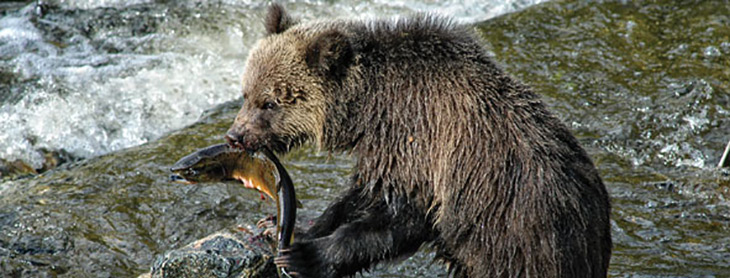
Although all species of bears, including black and grizzly bears, are technically of the order Carnivora, they are essentially omnivores that eat plants, insects, fish, and animals.
Bears spend most of their time perusing a patchwork of habitats throughout the year, feeding on vegetation, insects and other more reliable, though lower calorie food sources. Plant foods make up the majority of a bear’s diet – sometimes as much as 90 per cent.
However, fish and meat are important sources of protein and fat, though most non-coastal bears rely on carrion (including winter-killed animals). Some bears, however, become very effective predators on newborn elk, moose, deer or caribou. Others live in areas where salmon, suckers or other fish spawn for part of each year.
When bears emerge from their dens in the spring, food is in short supply. Although bears are hungry, most trees and shrubs won’t leaf for another month and only the grass at lower elevations has begun to green up. At this time of year, they are often found foraging on sunny, south-facing slopes where they can find overwintered berries or scavenge for winter-killed deer and moose.
The first green grasses and sedges often sprout right at the edges of streams or in open wetland meadows, which also makes these areas attractive. Grizzlies, with longer claws and powerful shoulders, will also dig for sweet-vetch roots, glacier lily bulbs and other starch-rich foods. Coastal bears find a milder reception, especially along low-elevation river valleys. They feed on the roots of skunk cabbage and sedges, or where they can find them, the well-cured carcasses of salmon that died the previous fall after spawning. Because food is relatively scarce during spring, bears continue to lose weight until well into June.
As the snowpack diminishes and the days lengthen, new greenery begins to sprout. In early summer, bears search for pockets of greenery in wet meadows and along creeks and rivers, on avalanche slopes, in aspen forests and along marsh edges. Bears that live near human development are often found grazing on the grasses of golf courses, ski runs, parks and other urban green spaces. As summer progresses, they spend a significant amount of time grubbing for ants and beetle larvae in fallen logs. Late in July or early in August, with the first ripening of huckleberries, blueberries and other berries, bears devote most of their attention to exploiting this high-energy food. In and around Banff National Park, grizzly bears have been documented eating more than 200,000 buffalo berries in a single day. In urban areas, bears can be found foraging on fruit trees and berry bushes.
Fall is a critical time for both black and grizzly bears, when they enter a state of hyperphagia and attempt to pack on as much fat as possible to see them trough their long winter sleep. As the berry crop succumbs to the first heavy frost, food supplies begin to dwindle. Bears, particularly coastal bears, feed on spawning fish where these occur in reliable concentrations. Elsewhere, bears turn again to greenery or roots, which often persists near water. They also wander widely looking for gut piles and wounded animals left by hunters.
Black and grizzly bears retire to their winter dens in November and December, when snow begins to accumulate, or, in coastal areas, when winter rains begin in earnest. In the lower latitudes and warmer climates, bears don’t need to hibernate as food is available year round. In fact, many urban bears are forgoing hibernation as they learn that people provide good winter forage – such as birdseed, pet food and garbage. During the denning period, bears do not usually eat or drink, though some bears have been observed leaving their winter dens and feeding on winter-killed animals.
Source: Bears: An Altitude SuperGuide by Kevin Van Tighem
